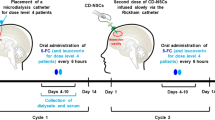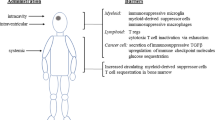Abstract
Since neural progenitor cells can engraft stably into brain tumors and differentiate along the neuronal and glial line, we tested the hypothesis that transplanted cytosine deaminase (CD)-expressing ST14A cells (an immortalized neural progenitor cell line) can convert locally 5-fluorocytosine (5-FC) into 5-fluorouracil (5-FU) and produce a regression of glioma tumors. ST14A, retrovirally transduced with the E. coli CD gene, showed a strong bystander effect on glioma cells as assessed by in vitro assay. Intracerebral injection of C6 glioma cells generated a rapidly growing tumoral mass. DiI prelabeled ST14A, coinjected into the rat brain with C6 glioma cells, survived in the tumoral mass up to 10 days and their number was not affected by in vivo 5-FC treatment. In contrast, a significant decrease of the glioma tumoral mass (−50%) was observed in 5-FC-treated rats. 5-FC had no effect on the tumor in the absence of CD-expressing ST14A cells. Our results support the feasibility of systems based on intratumoral transplantation of prodrug-converting cells for brain tumor therapy.
This is a preview of subscription content, access via your institution
Access options
Subscribe to this journal
Receive 12 print issues and online access
$259.00 per year
only $21.58 per issue
Buy this article
- Purchase on Springer Link
- Instant access to full article PDF
Prices may be subject to local taxes which are calculated during checkout








Similar content being viewed by others
References
Aghi M, Hochberg F, Breakefield XO . Prodrug activation enzymes in cancer gene therapy. J Gene Med. 2000;2:148–164.
Austin EA, Huber BE . A first step in the development of gene therapy for colorectal carcinoma: cloning, sequencing, and expression of Escherichia coli cytosine deaminase. Mol Pharmacol. 1993;43:380–387.
Polak A, Scholer HJ . Mode of action of 5-fluorocytosine and mechanisms of resistance. Chemotherapy. 1975;21:113–130.
Mullen CA, Kilstrup M, Blaese RM . Transfer of the bacterial gene for cytosine deaminase to mammalian cells confers lethal sensitivity to 5-fluorocytosine: a negative selection system. Proc Natl Acad Sci USA. 1992;89:33–37.
Freeman SM, Abboud CN, Whartenby KA, et al. The ‘bystander effect’: tumor regression when a fraction of the tumor mass is genetically modified. Cancer Res. 1993;53:5274–5283.
Huber BE, Austin EA, Richards CA, et al. Metabolism of 5-fluorocytosine to 5-fluorouracil in human colorectal tumor cells transduced with the cytosine deaminase gene: significant antitumor effects when only a small percentage of tumor cells express cytosine deaminase. Proc Natl Acad Sci USA. 1994;91:8302–8306.
Benedetti S, Pirola B, Pollo B, et al. Gene therapy of experimental brain tumors using neural progenitor cells. Nat Med. 2000;6:447–450.
Cattaneo E, Conti L . Generation and characterization of embryonic striatal conditionally immortalized ST14A cells. J Neurosci Res. 1998;53:223–234.
Mosmann T . Rapid colorimetric assay for cellular growth and survival: application to proliferation and cytotoxicity assays. J Immunol Methods. 1983;65:55–63.
Paxinos G, Watson C . The Rat Brain in Stereotaxic Coordinates, 2nd edn. Australia: Academic Press; 1986.
Mullen CA . Metabolic suicide genes in gene therapy. Pharmacol Ther. 1994;63:199–207.
Haberkorn U, Oberdorfer F, Gebert J, et al. Monitoring gene therapy with cytosine deaminase: in vitro studies using tritiated-5-fluorocytosine. J Nucl Med. 1996;37:87–94.
Vermes A, Guchelaar H-J, Dankert J . Flucytosine: a review of its pharmacology, clinical indications, pharmacokinetics, toxicity and drug interactions. J Antimicrob Chemother. 2000;46:171–179.
Huang RP, Hossain MZ, Sehgal A, et al. Reduced connexin43 expression in high-grade human brain glioma cells. J Surg Oncol. 1999;70:21–24.
McDonough WS, Johansson A, Joffee H, et al. Gap junction intercellular communication in gliomas is inversely related to cell motility. Int J Dev Neurosci. 1999;17:601–611.
Shinoura N, Chen L, Wani MA, et al. Protein and messenger RNA expression of connexin 43 in astrocytomas: implications in brain tumor gene therapy. J Neurosurg. 1996;84:839–846.
Soroceanu L, Manning JT, Sontheimer H . Expression of connexin-43 and functional gap junction coupling in human gliomas. Glia. 2001;33:107–117.
Zhu D, Caveney S, Kidder GM, et al. Transfection of C6 glioma cells with connexin 43 cDNA: analysis of expression, intercellular coupling, and cell proliferation. Proc Natl Acad Sci USA. 1991;88:1883–1887.
Lundberg C, Martinez-Serrano A, Cattaneo E, et al. Survival, integration, and differentiation of neural stem cell lines after transplantation to the adult rat striatum. Exp Neurol. 1997;145:342–360.
Aboody KS, Brown A, Rainov NG, et al. Neural stem cells display extensive tropism for pathology in adult brain: evidence from intracranial gliomas. Proc Natl Acad Sci USA. 2000;97:12846–12851.
Snyder EY, Taylor RM, Wolfe JH . Neural peogenitor cell engraftment corrects lysosomal storage throughout the MPS VII mouse brain. Nature. 1995;374:367–370.
Acknowledgements
We thank Prof. AM Giuffrida Stella for her continuous support and encouragement during all the stages of this work. Barresi V was supported by a postdoctoral fellowship (borsa post-dottorato ed assegno di ricerca) of the University of Catania (Italy) and a travel grant by the Italian Interuniversity Consortium for Biotechnologies (CIB). Portions of this work were presented at the Joint 18th Biennal Meeting of the International Society for Neurochemistry (ISN) and the 32nd Annual Meeting of the American Society for Neurochemistry (ASN) 26–31 August 2001, Buenos Aires (Argentina).
Author information
Authors and Affiliations
Corresponding author
Rights and permissions
About this article
Cite this article
Barresi, V., Belluardo, N., Sipione, S. et al. Transplantation of prodrug-converting neural progenitor cells for brain tumor therapy. Cancer Gene Ther 10, 396–402 (2003). https://doi.org/10.1038/sj.cgt.7700580
Received:
Published:
Issue Date:
DOI: https://doi.org/10.1038/sj.cgt.7700580
Keywords
This article is cited by
-
Recent progress in the research of suicide gene therapy for malignant glioma
Neurosurgical Review (2021)
-
A facile and scalable in production non-viral gene engineered mesenchymal stem cells for effective suppression of temozolomide-resistant (TMZR) glioblastoma growth
Stem Cell Research & Therapy (2020)
-
Current Perspective of Stem Cell Therapy in Neurodegenerative and Metabolic Diseases
Molecular Neurobiology (2017)
-
Antitumor Activity of Rat Mesenchymal Stem Cells during Direct or Indirect Co-Culturing with C6 Glioma Cells
Bulletin of Experimental Biology and Medicine (2016)
-
Functionally Active Gap Junctions between Connexin 43-Positive Mesenchymal Stem Cells and Glioma Cells
Bulletin of Experimental Biology and Medicine (2015)



